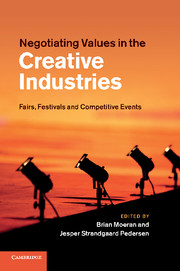Book contents
- Frontmatter
- Contents
- Figures
- Tables
- Contributors
- Acknowledgements
- Introduction
- 1 A Salon’s life
- 2 Art fairs
- 3 Biennalization and its discontents
- 4 Staging auctions
- 5 The book fair as a tournament of values
- 6 Inventing universal television
- 7 Transforming film product identities
- 8 Event institutionalization and maintenance
- 9 Tradition and transformation at the Fan Fair festival
- 10 Between art and commerce
- 11 Configuring sustainability at fashion week
- 12 An inconvenient truce
- 13 The retrospective use of tournament rituals in field configuration
- Afterword Converting values into other values
- Author index
- Subject index
- References
10 - Between art and commerce
London Fashion Week as trade fair and fashion spectacle
Published online by Cambridge University Press: 25 October 2011
- Frontmatter
- Contents
- Figures
- Tables
- Contributors
- Acknowledgements
- Introduction
- 1 A Salon’s life
- 2 Art fairs
- 3 Biennalization and its discontents
- 4 Staging auctions
- 5 The book fair as a tournament of values
- 6 Inventing universal television
- 7 Transforming film product identities
- 8 Event institutionalization and maintenance
- 9 Tradition and transformation at the Fan Fair festival
- 10 Between art and commerce
- 11 Configuring sustainability at fashion week
- 12 An inconvenient truce
- 13 The retrospective use of tournament rituals in field configuration
- Afterword Converting values into other values
- Author index
- Subject index
- References
Summary
Traditionally beginning in New York and ending in Paris, ‘fashion weeks’, also known as the ‘collections’, showcase the up-coming season’s prêt-à-porter clothing. Fashion week is an important moment within the life of the industry globally, also acting as a key instrument in ‘fashion-branding the city’ (Rocamora, 2009: 79–85). As one stop in this international circuit, London Fashion Week (LFW) comprises a large exhibition of designers’ work in the manner of a trade show but also, more famously, a series of catwalk shows covered by the world’s press. To garner publicity these shows are often spectacular events which involve much more than simply the clothes: they are sensory experiences which invoke moods, sensations and associations around the collection, using particular models, lighting, music and other props. Narratives are created around the various collections presented that help support their branding and add value to the clothes on show. These events, not the trade stands, are what grab press and public attention. Indeed, LFW is a major promotional opportunity for British fashion designers and one way to secure both the attention of the world’s press as well as generating actual sales. So, although fashion shows usually make a net loss, showing at LFW can secure important symbolic capital in the form of status accrued through good press coverage, and enable a designer to carve out a visible presence in the fashion world. As described by Aspers (2001) and Entwistle (2009), the cultural value far outweighs any immediate financial gain, although the hope is that the symbolic status accrued will, at some point in time, translate into financial success. Thus, fashion week in general, and LFW in particular, remain situated in an intermediary position between art (Skov et al., 2009) and commerce.
This chapter, based on two separate fieldwork studies, analyses the specific characteristics of LFW as a particular fashion trade fair. While we attended different fashion weeks (during 2002–4), and observed different participants as part of two separate projects (discussed in more detail below), in subsequent discussions we were struck by our remarkably similar observations. We both noted how LFW, in bringing together the key people whose work constitutes the wider field of fashion, mapped out, quite literally in spatial terms, all the key agents and institutions within the field of fashion. These key people include designers, models, journalists and buyers from stores around the world, fashion stylists and celebrities, as well as less important figures, such as fashion students, who exist on the margins of the field.
- Type
- Chapter
- Information
- Negotiating Values in the Creative IndustriesFairs, Festivals and Competitive Events, pp. 249 - 269Publisher: Cambridge University PressPrint publication year: 2011
References
- 7
- Cited by



